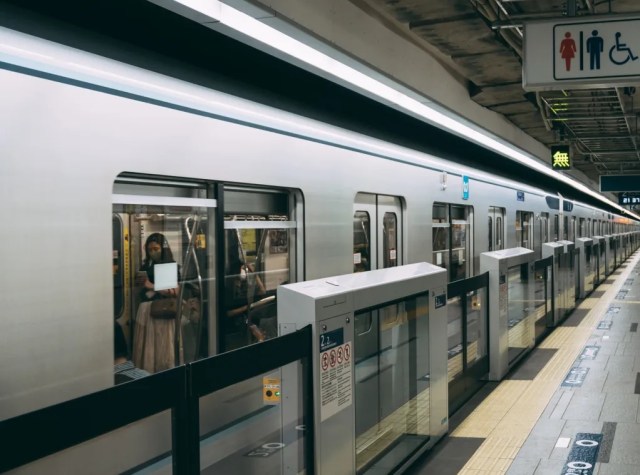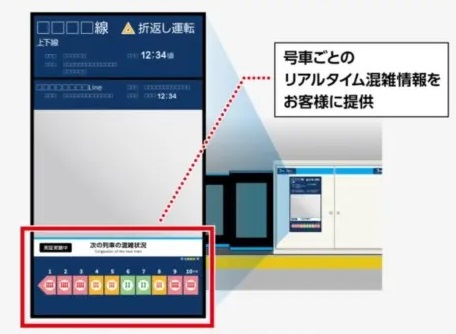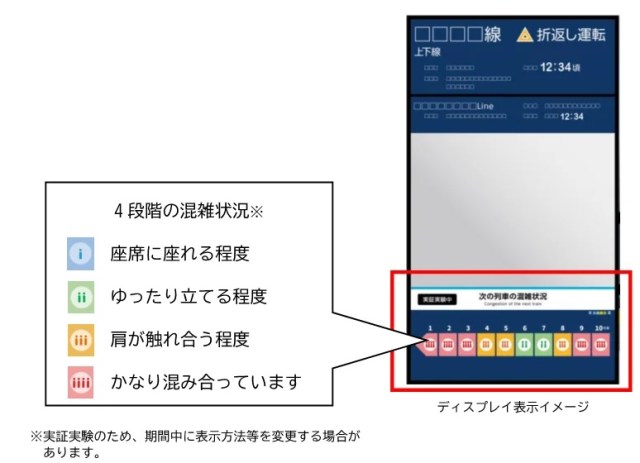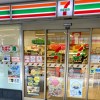
Test program could help Tokyo commuters go from crazy crowded commutes to simply very crowded commutes.
At rush hour, you can pretty much expect every subway train in downtown Tokyo to be crowded. Even on a crowded train, though, not every car is going to be equally crowded.
Wouldn’t it be more comfortable for everyone to spread out as much as possible, resulting in an even distribution of people between the cars? Sure, but there’s more to it than that. Some people might be riding in a certain car because when the train stops at their destination, that car is the closest one to the exit they plan to take. Or maybe an especially large number of people happened to hop into the same section of the train at a particular station, and that car is now too crowded for them to squirm their way to a different one.
So all else equal, if you’re standing on the platform waiting for a train, ideally you want to know where the least crowded cars are going to be, so you can get on the train there. Luckily, there’s a way to do just that, thanks to a new notification system from Tokyo Metro.
A number of Tokyo Metro stations now have automated platform gates with video display screens on them. All that Tokyo Metro needs to do is use those screens to show how crowded each of the cars are on the next arriving train, so that the people who’ll be getting on can pick the least crowded ones.
The display uses a four-level color-coded scale, starting with blue (car has empty seats) and progressing to green (no empty seats, but relatively uncrowded), orange (standing only, shoulders will be in contact with others’), and red (very crowded).
To do all that, Tokyo Metro will use platform-mounted depth-sensing cameras to perform a visual check of the train and feed that information to an A.I. program, which calculates the crowdedness rating and passes the result on to the display at the next station. The company will also be using passenger survey responses to help with fine-tuning.
Congestion displays went into service on Wednesday at Waseda Station on the Tozai Line, specifically on the platform for eastbound trains, as part of a test program. It’s a smart choice for a test site. The stop before Waseda is Takadanobaba Station, a transfer station that connects to both the Yamanote downtown loop train line and the Seibu Shinjuku train line which links downtown Tokyo and residential neighborhoods to the west, as does the Tozai Line itself. Every weekday morning Tozai trains headed east are packed with students on their way to Waseda University and office workers who’ll continue farther down the line to Tokyo’s financial district, so anything that can make commutes smoother would be a plus.
The test will continue until the end of March, traditionally the end of the business year in Japan, and if it works well we might be seeing crowdedness displays on other Tokyo Metro platforms in the near future.
Source: PR Times
Top image: Pakutaso
Insert images: PR Times
● Want to hear about SoraNews24’s latest articles as soon as they’re published? Follow us on Facebook and Twitter!
Follow Casey on Twitter, where he used to start every day with a packed Takadanobaba-to-Waseda subway ride.



 Tokyo subway bribes people with free noodles to get them to take earlier, non-rush hour trains
Tokyo subway bribes people with free noodles to get them to take earlier, non-rush hour trains Filled to bursting point? Rush-hour crush on Tokyo subway leaves train with broken window
Filled to bursting point? Rush-hour crush on Tokyo subway leaves train with broken window These are the 11 most crowded trains in Japan…and surprise! They’re all in the Tokyo area
These are the 11 most crowded trains in Japan…and surprise! They’re all in the Tokyo area Commuter chaos at Shibuya Station after glass window breaks on door of crowded Japanese train
Commuter chaos at Shibuya Station after glass window breaks on door of crowded Japanese train Tokyo train adding family-only cars to evening commuter express in March
Tokyo train adding family-only cars to evening commuter express in March How to order snacks on a Shinkansen bullet train in Japan
How to order snacks on a Shinkansen bullet train in Japan Japan’s new difficult-to-drink-from beer glass protects your liver, but it’s a brutal experience
Japan’s new difficult-to-drink-from beer glass protects your liver, but it’s a brutal experience Come play hide-and-seek on a deserted Japanese island this August and November
Come play hide-and-seek on a deserted Japanese island this August and November New Pokémon ice cream, dessert drinks, and cool merch coming to Baskin-Robbins Japan【Pics】
New Pokémon ice cream, dessert drinks, and cool merch coming to Baskin-Robbins Japan【Pics】 New samurai glasses are Japan’s latest weird must-have souvenir
New samurai glasses are Japan’s latest weird must-have souvenir Nara unveils new vending machines that sell deer crackers
Nara unveils new vending machines that sell deer crackers Nintendo history you can feel – Super NES, N64, and GameCube controllers become capsule toys
Nintendo history you can feel – Super NES, N64, and GameCube controllers become capsule toys Demon Slayer: Kimetsu no Yaiba gets new roller coaster attractions and food at Universal Studios Japan
Demon Slayer: Kimetsu no Yaiba gets new roller coaster attractions and food at Universal Studios Japan How to use the new floating hologram registers at 7-Eleven
How to use the new floating hologram registers at 7-Eleven High-fashion Totoro cuddle purse is like an elegant stroll in the forest【Photos】
High-fashion Totoro cuddle purse is like an elegant stroll in the forest【Photos】 Hello, cosmetics! Clinique teams up with Hello Kitty this summer for first-time collaboration
Hello, cosmetics! Clinique teams up with Hello Kitty this summer for first-time collaboration “The most Delicious Cup Noodle in history” – Japan’s French Cup Noodle wins our heart【Taste test】
“The most Delicious Cup Noodle in history” – Japan’s French Cup Noodle wins our heart【Taste test】 Starbucks releases a cute Frappuccino and Unicorn Cake…but not in Japan
Starbucks releases a cute Frappuccino and Unicorn Cake…but not in Japan Kyoto Tower mascot termination reveals dark side behind cute Japanese characters
Kyoto Tower mascot termination reveals dark side behind cute Japanese characters McDonald’s Japan’s Soft Twist Tower: A phantom ice cream only sold at select branches
McDonald’s Japan’s Soft Twist Tower: A phantom ice cream only sold at select branches Yabai Ramen: What makes this Japanese ramen so dangerous?
Yabai Ramen: What makes this Japanese ramen so dangerous? Finally! Nintendo Japan expands Switch 8-bit controller sales to everybody, Online member or not
Finally! Nintendo Japan expands Switch 8-bit controller sales to everybody, Online member or not Japanese government wants to build luxury resorts in all national parks for foreign tourists
Japanese government wants to build luxury resorts in all national parks for foreign tourists To combat declining birth rate, Japan to begin offering “Breeding Visas” to foreigners
To combat declining birth rate, Japan to begin offering “Breeding Visas” to foreigners 10 things you should buy at 7-Eleven in Japan
10 things you should buy at 7-Eleven in Japan Studio Ghibli releases anime heroine cosplay dresses that are super comfy to wear
Studio Ghibli releases anime heroine cosplay dresses that are super comfy to wear Woman charged for driving suitcase without a license in Osaka
Woman charged for driving suitcase without a license in Osaka Studio Ghibli unveils My Neighbour Totoro miniature house model
Studio Ghibli unveils My Neighbour Totoro miniature house model Kyoto experiencing problems with foreign tourists not paying for bus fares, but not on purpose
Kyoto experiencing problems with foreign tourists not paying for bus fares, but not on purpose Fighting mild hunger with a Japanese soda that turns into jelly in the stomach【Taste test】
Fighting mild hunger with a Japanese soda that turns into jelly in the stomach【Taste test】 Studio Ghibli’s Howl’s Moving Castle tapestry unveiled in Japan for first time
Studio Ghibli’s Howl’s Moving Castle tapestry unveiled in Japan for first time McDonald’s new Happy Meals offer up cute and practical Sanrio lifestyle goods
McDonald’s new Happy Meals offer up cute and practical Sanrio lifestyle goods Sales of Japan’s most convenient train ticket/shopping payment cards suspended indefinitely
Sales of Japan’s most convenient train ticket/shopping payment cards suspended indefinitely Sold-out Studio Ghibli desktop humidifiers are back so Totoro can help you through the dry season
Sold-out Studio Ghibli desktop humidifiers are back so Totoro can help you through the dry season Japanese government to make first change to romanization spelling rules since the 1950s
Japanese government to make first change to romanization spelling rules since the 1950s Foreigner’s request for help in Tokyo makes us sad for the state of society
Foreigner’s request for help in Tokyo makes us sad for the state of society Ghibli founders Toshio Suzuki and Hayao Miyazaki contribute to Japanese whisky Totoro label design
Ghibli founders Toshio Suzuki and Hayao Miyazaki contribute to Japanese whisky Totoro label design Doraemon found buried at sea as scene from 1993 anime becomes real life【Photos】
Doraemon found buried at sea as scene from 1993 anime becomes real life【Photos】 Tokyo’s most famous Starbucks is closed
Tokyo’s most famous Starbucks is closed Princesses, fruits, and blacksmiths: Study reveals the 30 most unusual family names in Japan
Princesses, fruits, and blacksmiths: Study reveals the 30 most unusual family names in Japan Tokyo subway ”phantom station” reveals itself to passengers for first time in nearly 90 years
Tokyo subway ”phantom station” reveals itself to passengers for first time in nearly 90 years End-of-the-line exploring in Japan: Visiting Hashimoto Station
End-of-the-line exploring in Japan: Visiting Hashimoto Station Tokyo’s busiest train line to be partially shut down this weekend as part of Shibuya renovations
Tokyo’s busiest train line to be partially shut down this weekend as part of Shibuya renovations One of Tokyo’s busiest subway lines is adding women-only cars
One of Tokyo’s busiest subway lines is adding women-only cars What’s it like traversing Tokyo using only wheelchair accessible routes?
What’s it like traversing Tokyo using only wheelchair accessible routes? Japan Railways to release new anti-groper smartphone app to help victims before chikan gets away
Japan Railways to release new anti-groper smartphone app to help victims before chikan gets away 11 cheapest Tokyo neighborhoods to rent an apartment in show living here’s not an impossible dream
11 cheapest Tokyo neighborhoods to rent an apartment in show living here’s not an impossible dream “Men-only train car” to run in Tokyo as part of “Weak Men’s” association awareness campaign
“Men-only train car” to run in Tokyo as part of “Weak Men’s” association awareness campaign Messaging app LINE experiments with service to help pregnant women find seats on trains
Messaging app LINE experiments with service to help pregnant women find seats on trains River of salarymen appears on totally normal, completely crazy day in Tokyo station【Video】
River of salarymen appears on totally normal, completely crazy day in Tokyo station【Video】 Taste the floor of a Japanese train station with new limited-edition chocolates from Tokyo Metro
Taste the floor of a Japanese train station with new limited-edition chocolates from Tokyo Metro Smartphone app finds empty restroom stalls in Tokyo subway station, makes pooing easier than ever
Smartphone app finds empty restroom stalls in Tokyo subway station, makes pooing easier than ever Photo of man taking a dump on Tokyo subway floor is full of amusing background details
Photo of man taking a dump on Tokyo subway floor is full of amusing background details Studio Ghibli and Tokyo Metro team up for summer stamp rally with adorable Catbus prize
Studio Ghibli and Tokyo Metro team up for summer stamp rally with adorable Catbus prize Man dressed as Batman’s Joker commits stabbing/arson attack on Tokyo train on Halloween night
Man dressed as Batman’s Joker commits stabbing/arson attack on Tokyo train on Halloween night Thousands oppose Osaka Metro’s plan to change major stations in giant boats and fabric swatches
Thousands oppose Osaka Metro’s plan to change major stations in giant boats and fabric swatches
Leave a Reply